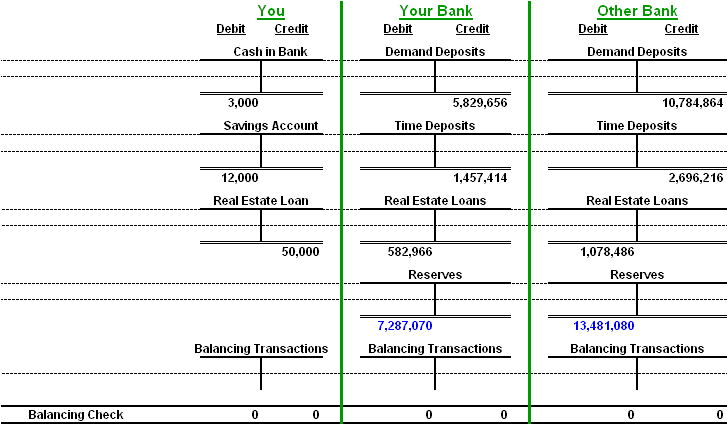The Free Market Center
The Free Market Center

Before recording any transactions, the relevant accounts for You, Your Bank and another bank (Other Bank) reflect the balances in the table of "T-accounts" above.
I have transferred the pertinent account information for you from Financial Information to the two left hand columns, headed "You". You have $3,000 in Cash in Bank (your checking account), $12,000 in a Saving Account, and you currently owe $50,000 to Other Bank for a Real Estate Loan (in right two columns of table). Cash in Bank and Savings Account have debit balances, indicating your use of these funds: to keep them in the bank. The Real Estate Loan, on the other hand, has a credit balance, representing a source of funds.
The middle two columns show the pertinent accounts for Your Bank, where you bank. The credit balances in Demand Deposits and Time Deposits of $5.8 Million and $1.5 Million respectively, reflect liabilities to depositors (or sources for Your Bank). The bank also has a Reserves account with a debit balance of $7.3 Million. The bank has used these funds to place in this account.
Note: Although this fact does not influence this example, the debit balance in Reserves represents a deposit account with the Federal Reserve bank. For the sake of these early examples, however, it does not matter where the bank keeps its reserves. They could, hypothetically, keep them in their own vault.
The accounts in the two right hand columns reflect source and uses (credits and debits) for another bank, which I cleverly named Other Bank.
Each of these entities has an account, which I have titled Balancing Transactions. To save space in this presentation this account consolidates balancing entries for accounts not included in the significant accounts above.
The last row in this chart (titled Balancing Check) shows the sums of debit and credit entries. I placed this row here to show how the sources and uses (debits and credits) balance (or equal). The sums all equal zero in this table because I have made no entries yet. You will see the effect of entries in later tables.
This explanation applies to all of the tables that I have used to demonstrate transaction in the banking system that affect the quantity of money or the transfer of funds between banking entities. You may wish to refer to this explanation from time to time.
© 2010—2020 The Free Market Center & James B. Berger. All rights reserved.
To contact Jim Berger, e-mail: